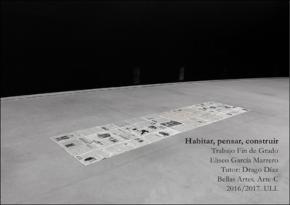Habitar, construir, pensar
Autor
García Marrero, EliseoFecha
2017Resumen
El planteamiento de la ciudad se enfoca desde diferentes
vertientes, el espacio planificado, el espacio representado
y el espacio vivencial. Cada una de estas categorías, representa un planteamiento dentro de todo el entramado
social. El espacio planificado se centra en la organización
previa del espacio y la distribución cartográfica de esta.
Atiende a las formas más férreas y estructuradas de la ciudad, donde las transformaciones y nuevas infraestructuras
son perceptibles. En el espacio representado, se gesta desde lo no tangible, no visible, pero sí existente. La ciudad
es un mero transmisor de ideas o situaciones que sirven al
artista para abordar una perspectiva creativa y que no se
centran en la formalidad. Por último tenemos el espacio
vivencial, aquel donde se generan afluencias de personas,
colectividades de individuos que con su presencia y motivaciones conforman este espacio. Este espacio vivencial se
aborda desde lo público o exterior, allí donde seres desconocidos entre sí, generan grupo o masa social, con una
finalidad en común o no; y también se aborda desde lo
privado o interior, allí donde se generan sinergias sociales
desde lo afectivo o contractual. Partiendo de las distintas
categorías a las que nos hemos referido, se produce un
juego de posibilidades, en donde las piezas fluctúan entre
los diferentes espacios, acercándose a algunos de ellos, por
matices o intención del artista, permitiendo una comprensión sesgada de los lugares territoriales planteados. The city approach is focused from different perspectives:
the planned space, the represented space and the experiential space. Each one of these categories is a different
approach represented in a whole social framework. The
planned space is focused on te previous organization of
the space and its cartographic distribution. It attends to
the most solid and structured forms of the city, where
transformations and new infrastructures are noticeable.
The represented space is originated by not touchable or
visible things, but existent ones. The city just transmites
ideas or situations that are useful to the artist to achieve a
creative perspective, not focused in formality. In last place,
the experiential space is that one where is generated influx
of people and collectivities of individuals, who make up
this space by their presence and motivations. This experiential space has a public or external approach, where
unknown beings create a group or social mass whit a common purpose. It can also be observed from a private and
internal view, where social synergies are generated from
affective and contractual ambit.
Starting from the different perspectives we previously
mentioned, a range of possibilities is produced, where
pieces fluctuate between different spaces, approaching
some of them by nuances or the artist’s purpose, getting a
biased understanding of the territorial spaces proposed




